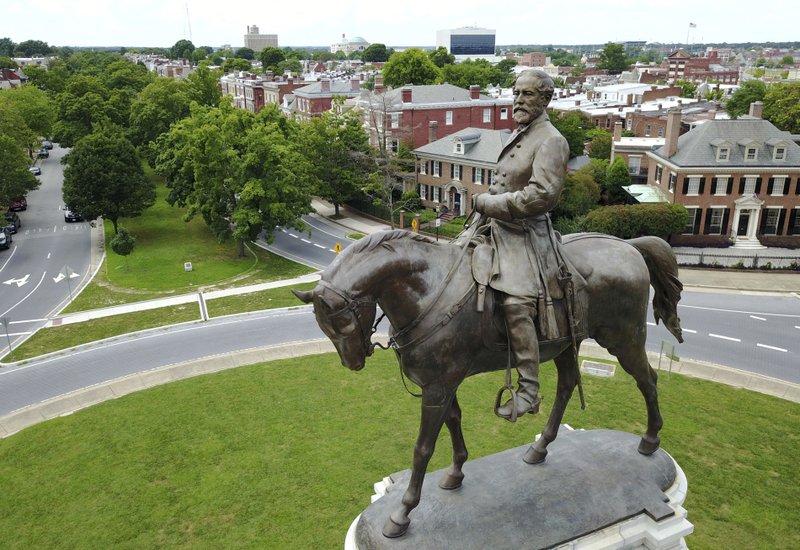A judge dismissed a legal challenge Monday preventing Virginia Gov. Ralph Northam’s administration from removing an enormous statue of Confederate Gen. Robert E. Lee, but immediately imposed another injunction in a different lawsuit.
The new 90-day injunction bars the state from “removing, altering, or dismantling, in any way” the larger-than-life statue or its massive pedestal while the claims in a lawsuit filed by a group of Richmond property owners are litigated.
Richmond Circuit Court Judge W. Reilly Marchant wrote that “the public interest does weigh in favor” of a temporary injunction.
Separately, Marchant dismissed entirely as not “legally viable” the claims filed by a descendant of signatories to an 1890 deed that transferred the statue to the state, and he dissolved an existing injunction in that case.
Plaintiff William C. Gregory, the great-grandson of land donors, had argued the state agreed to “faithfully guard” and “affectionately protect” the statue on historic Monument Avenue. The Associated Press sent an inquiry to his attorney seeking comment.
The governor appreciates the dismissal of the Gregory case and “looks forward to another victory in court as soon as possible,” his spokeswoman, Alena Yarmosky, said in a statement.
“This statue will come down – and Virginia will be better for it,” she said.
Northam announced plans to remove the statue in early June, citing the pain felt across the country about the death of George Floyd in Minneapolis.
Should a court eventually clear the way, it won’t be a simple task to remove the 21-foot-high (6.4-meter-high) equestrian statue, which the state has said weighs about 12 tons (11 metric tonnes). A state board’s removal plan calls for cutting it into three sections for eventual reassembly elsewhere.
Now covered by graffiti, the Lee monument has become a gathering spot for the sustained protests since Floyd’s death.
In the property owners’ case, Marchant found that the plaintiffs have the general standing to sue, and then considered one of their five claims, finding that the plaintiffs are likely to succeed “under the common law doctrine of restrictive covenants running with the land.”
He said he would hear evidence and arguments on all five counts at another hearing. Court records did not indicate such a hearing has been scheduled.
Four of the plaintiffs own property near statue; another is a trustee of a property owner. Among them is Helen Marie Taylor, a longtime Monument Avenue resident and defender of the statues. They claim that removing the Lee statue — the last Confederate statue now standing on Monument Avenue — could result in the loss of the neighborhood’s National Historic Landmark designation, “which will have a substantial adverse impact “ on the plaintiffs, ”including the loss of favorable tax treatment and reduction in property values.”
Virginia Attorney General Mark Herring has filed a motion to dismiss their lawsuit, and “remains committed to ensuring this divisive, antiquated relic is removed as soon as possible,” according to a statement from his spokeswoman, Charlotte Gomer.
(AP)












One Response
Lee was a traitor and a lousy general. He ordered two rash invasions of the North, both of which ended in defeat. On the second, he ordered Pickett’s Charge, one of the most stupid military actions by any army in North America ever.
His fame is largely because of the successful attempts by Confederate apologists to rewrite history after the war. Put up a statue instead of Maj. Gen. George Thomas, a Virginian who was not a traitor, fought for the Union, and was a better general anyway. He has no statues in Virginia.
Or if you insist on a Confederate General, put up a statue of Major General William Mahone, a true Confederate hero for his saving Lee’s army at the Battle of the Crater in the Siege of Petersburg. Other than at that battlefield there is not a single statue of him anywhere. Before and after the war he was instrumental in building what would become the Norfolk and Western Railway, helping Virginia to become the only industrialized state in the South at the time. But even more importantly, after the war he founded a multiracial political party, which during the brief period it controlled the state government in the 1880s finally gave the state a public school system across the state for both blacks and whites, with blacks permitted to teach in black schools, increased funding for the state’s agricultural college (now Virginia Tech), started an agricultural college for blacks (now Virginia State), abolished flogging for crimes, and abolished the poll tax that prevented both poor whites and blacks from voting. (Progressive Democrats would reinstitute it in 1902. 🙁 ) Many blacks would be appointed or elected to public office and the city of Danville even had an integrated police department for a short time. But the racists who put up the statues in Richmond did not want anyone to know about someone like Mahone — they wanted white supremacy.